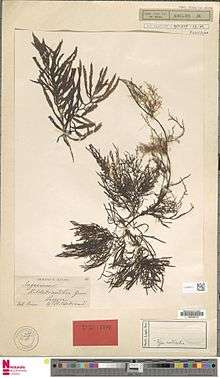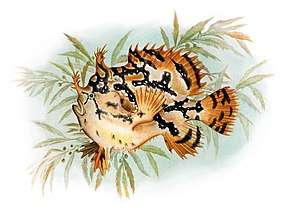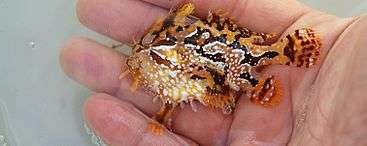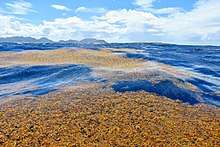Sargassum
Sargassum is a genus of brown (class Phaeophyceae) macroalgae (seaweed) in the order Fucales. Numerous species are distributed throughout the temperate and tropical oceans of the world, where they generally inhabit shallow water and coral reefs, and the genus is widely known for its planktonic (free-floating) species. Most species within the class Phaeophyceae are predominantly cold-water organisms that benefit from nutrients upwelling, but the genus Sargassum appears to be an exception.[1] Any number of the normally benthic species may take on a planktonic, often pelagic existence after being removed from reefs during rough weather; however, two species (S. natans and S. fluitans) have become holopelagic—reproducing vegetatively and never attaching to the seafloor during their lifecycles. The Atlantic Ocean's Sargasso Sea was named after the algae, as it hosts a large amount of Sargassum.[2]
| Sargassum | |
|---|---|
 | |
| Scientific classification | |
| Kingdom: | Chromista |
| Phylum: | Ochrophyta |
| Class: | Phaeophyceae |
| Order: | Fucales |
| Family: | Sargassaceae |
| Genus: | Sargassum |
| Species | |
|
See list | |


History
Sargassum was named by the Portuguese sailors who found it in the Sargasso Sea after the wooly rock rose (Halimium lasianthum) that grew in their water wells at home, and that was called sargaço in Portuguese (Portuguese pronunciation: [sɐɾˈɣasu]).[3]
The Florida Keys and mainland South Florida are well known for their high levels of Sargassum covering their shores. Gulfweed was observed by Columbus. Although it was formerly thought to cover the entirety of the Sargasso Sea, making navigation impossible, it has since been found to occur only in drifts.[4]
Sargassum species are also cultivated and cleaned for use as an herbal remedy. Many Chinese herbalists prescribe powdered Sargassum—either the species S. pallidum, or more rarely, hijiki, S. fusiforme—in doses of 0.5 gram dissolved in warm water and drunk as a tea. It is called 海藻; hǎizǎo in traditional Chinese medicine, where it is used to resolve "heat phlegm".[5]
Description
Species of this genus of algae may grow to a length of several metres. They are generally brown or dark green in color and consist of a holdfast, a stipe, and a frond. Oogonia and antheridia occur in conceptacles embedded in receptacles on special branches.[6] Some species have berrylike gas-filled bladders that help the fronds float to promote photosynthesis. Many have a rough, sticky texture that, along with a robust but flexible body, helps it withstand strong water currents.
Ecology
Large, pelagic mats of Sargassum in the Sargasso Sea act as one of the only habitats available for ecosystem development; this is because the Sargasso Sea lacks any land boundaries.[7] The Sargassum patches act as a refuge for many species in different parts of their development, but also as a permanent residence for endemic species that can only be found living on and within the Sargassum.[8] These endemic organisms have specialized patterns and colorations that mimic the Sargassum and allow them to be impressively camouflaged in their environment. In total, these Sargassum mats are home to more than 11 phyla and over 100 different species.[9] There is also a total of 81 fish species (36 families represented) that reside in the Sargassum or utilize it for parts of their life cycles.[10] Other marine organisms, such as young sea turtles, will use the Sargassum as shelter and a resource for food until they reach a size at which they can survive elsewhere. This community is being affected by humans due to overfishing, trash and other types of pollution, and boat traffic, which could eventually lead to the demise of this diverse and unique habitat.[8] Below is a list of organisms that are associated with the Sargassum in the Sargasso Sea.
The Sargasso Sea plays a major role in the migration of catadromous eel species such as the European eel, the American eel, and the American conger eel. The larvae of these species hatch within the sea and as they grow they travel to Europe or the East Coast of North America. Later in life, the matured eel migrates back to the Sargasso Sea to spawn and lay eggs. It is also believed that after hatching, young Loggerhead sea turtles use currents such as the Gulf Stream to travel to the Sargasso Sea, where they use the sargassum as cover from predators until they are mature.[11][12]
Organisms found in the pelagic Sargassum patches,[13][14][8]
- Arthropods
- Worms
- Annelid worms
- Flatworms
- Mollusks
- Fish
- Sargassum fish
- Porcupinefish
- Triplefin
- Planehead filefish
- European eel
- American eel
- American conger eel
- Others
- Sea turtles
Sargassum is commonly found in the beach drift near Sargassum beds, where they are also known as gulfweed, a term that also can mean all seaweed species washed up on shore.
Sargassum species are found throughout tropical areas of the world and are often the most obvious macrophyte in near-shore areas where Sargassum beds often occur near coral reefs. The plants grow subtidally and attach to coral, rocks, or shells in moderately exposed or sheltered rocky or pebble areas. These tropical populations often undergo seasonal cycles of growth and decay in concert with seasonal changes in sea temperature.[15] In tropical Sargassum species that are often preferentially consumed by herbivorous fishes and echinoids, a relatively low level of phenolics and tannins occurs.[16]



Some other small fish, such as this juvenile puffer (right), are also found in sargassum.
Sargassum adrift in Gulf Stream
The Gulf has the second largest concentration of sargassum of any body of water in the world. A fair amount of it washes out through the Straits of Florida in the Gulf Stream and ends up in the Sargasso Sea in the Atlantic Ocean off the East Coast of the United States.
— Bob Shipp[17]
We rounded Hatteras in fair weather, and saw the line between the brilliant blue Gulf Stream full of gulf weed and the muddy grayish shore water as clearly defined as that between the sidewalk and the roadway in a street.
Sargassum crisis in the Caribbean Sea

In summer 2015, large quantities of different species of Sargassum accumulated along the shores of many of the countries on the Caribbean Sea. Some of the affected islands and regions include the Caribbean coast of Mexico, the Dominican Republic, Barbados, and Trinidad and Tobago.[19] Another large outbreak occurred in 2018,[20] which resulted in 6,000 square kilometers of Sargassum coverage, almost twice as much as the 2015 outbreak. [21]
The algae wash ashore, pile up on beaches, and decay, often causing a foul odor, releasing fumes of sulphur compounds that rust metals, can turn taps black in shore houses, damage modern conveniences, and cause respiratory problems, particularly for asthmatics. A doctor in Guadeloupe recorded 52 patients as having Sargassum-related symptoms. Insurance problems arise for tourist operators and homeowners, where the household and business losses do not fall into previous insurance categories. Wildlife also suffer; for example, sea turtle hatchlings die on their way to open water. The causes, effects, and potential solutions of the outbreak are a topic of international discussion.[22]
One method of cleaning is by spade and barrow onshore. Another is by raking boats offshore. Barrages of shallow nets floated by long buoys can be used to ward off algae drifts, depending on wave height and current. On the Caribbean island of Saint Martin, backhoes are also used in the process of clean up once the Sargassum weed reaches the shorelines.[23][24]
Researchers say that the Sargassum outbreak started in 2011, but it has become worse over the years. As it is cleaned up on the shorelines, in a matter of a week, the shorelines are once again filled in masses. It is still a recurring problem, in June 2019 the Mexican government said they would spend $2.7m (£2.1m) to build four boats designed to remove seaweed as well as new barriers to retain it.[25][26]
Several factors could explain the proliferation of Sargassum in the area in recent years. These include the rise of sea temperature and the change of sea currents due to climate change. Nutrients from agricultural fertilizers and wastewater from the cities that end up in the sea could also make the algae bloom.[19]
References
- Hogan, C. Michael (2011). Monosson, E.; Cleveland, C.J. (eds.). "Algae § 1.3 Brown_algae". Encyclopedia of Earth. Washington DC: National Council for Science and the Environment.
- "Sargasso". Straight Dope.
- Gómez de Silva, Guido 1988. Breve diccionario etimológico de la lengua española. Fondo de Cultura Económica, Mexico City, ISBN 968-16-2812-8, p. 627.
- David McFadden (August 10, 2015). "Stinking mats of seaweed piling up on Caribbean beaches". Retrieved August 10, 2015.
- Xu Li & Wang Wei (2002). Chinese Materia Medica: Combinations and Applications. Donica Publishing Ltd. p. 425. ISBN 978-1-901149-02-9.
- Abbott, Isabella A.; Hollenberg, George J. (1992). "Phaeophyta § Sargassum". Marine Algae of California. Stanford University Press. pp. 272–. ISBN 978-0-8047-2152-3.
- US Department of Commerce, National Oceanic and Atmospheric Administration. (2013, June 01). What is the Sargasso Sea? Retrieved November 28, 2017, from https://oceanservice.noaa.gov/facts/sargassosea.html
- Laffoley, D.d’A., Roe, H.S.J., Angel, M.V., Ardron, J., Bates, N.R., Boyd, I.L., Brooke, S., Buck, K.N., Carlson, C.A., Causey, B., Conte, M.H., Christiansen, S., Cleary, J., Donnelly, J., Earle, S.A., Edwards, R., Gjerde, K.M., Giovannoni, S.J., Gulick, S., Gollock, M., Hallett, J., Halpin, P., Hanel, R., Hemphill, A., Johnson, R.J., Knap, A.H., Lomas, M.W., McKenna, S.A., Miller, M.J., Miller, P.I., Ming, F.W., Moffitt, R., Nelson, N.B., Parson, L., Peters, A.J., Pitt, J., Rouja, P., Roberts, J., Roberts, J., Seigel, D.A., Siuda, A.N.S., Steinberg, D.K., Stevenson, A., Sumaila, V.R., Swartz, W., Thorrold, S., Trott, T.M., and V. Vats. (2011). The protection and management of the Sargasso Sea: The golden floating rainforest of the Atlantic Ocean. Summary Science and Supporting Evidence Case. Sargasso Sea Alliance, 44 pp.
- Stoner, A. W., & Greening, H. S. (1984). Geographic variation in the macrofaunal associates of pelagic Sargassum and some biogeographic implications. Marine Ecology Progress Series, 20, 185–192. doi:10.3354/meps020185
- Casazza, T.L.; Ross, S.W., PhD. "Sargassum: A Complex 'Island' Community at Sea". NOAA Ocean Explorer. Retrieved 27 September 2018.
- "Turtles return home after UK stay". BBC News. 2008-06-30. Retrieved 2010-05-23.
- "Satellites track turtle 'lost years'". BBC News. 2014-03-05. Retrieved 2014-03-05.
- Casazza, T. L., & Ross, S. W., PhD. (2010, August 25). Sargassum: A Complex 'Island' Community at Sea. Retrieved September 27, 2018, from https://oceanexplorer.noaa.gov/explorations/03edge/background/sargassum/sargassum.html
- Huffard, C. L., Thun, S. V., Sherman, A. D., Sealey, K., & Smith, K. L. (2014). Pelagic Sargassum community change over a 40-year period: temporal and spatial variability. Marine Biology, 161(12), 2735–2751. doi:10.1007/s00227-014-2539-y
- Fulton CJ, Depczynski M, Holmes TH, Noble MM, Radford B, Wernberg TH, Wilson SK (2014). "Sea temperature shapes seasonal fluctuations in seaweed biomass within the Ningaloo coral reef ecosystem". Limnology & Oceanography. 59 (1): 156–166. doi:10.4319/lo.2014.59.1.0156.
- Steinberg, Peter D. (1986). "Chemical defenses and the susceptibility of tropical marine brown algae to herbivores". Oecologia. 69 (4): 628–630. doi:10.1007/BF00410374. PMID 28311627.
- Bob Shipp interviewed by Jeff Young (16 July 2010). "Living on Earth: The Need for Seaweed". PRI's Environmental News Magazine.
- Pinchot, Gifford (1930). To the South Seas. New York City: Blue Ribbon Books. p. 14.
- "Stinking seaweed piling high on beaches in tourism-dependent Caribbean". CBC News.
- "Sargassum: A Nightmare in the Caribbean". Repeating Islands. 4 April 2018. Retrieved 30 May 2018.
- Wang, Mengqiu; Hu, Chuanmin; Barnes, Brian; Mitchum, Gary; Lapointe, Brian; Montoya, Joseph (2019). "The great Atlantic Sargassum belt". Marine Ecology. 365 (6448): 83–87. doi:10.1126/science.aaw7912. PMID 31273122.
- "International Conference on Sargassum in Guadeloupe". Sargassum 2019. Retrieved 2019-11-27.
- "Guadeloupe: The invasion of sargassum seaweed". Fr24.
- "Sargassum seaweed, 'greatest single threat to the Caribbean tourism industry'". MercoPress.
- "Mexico's top Caribbean beaches hit by seaweed infestation". BBC.
- "Sargassum seaweed on Caribbean islands: an international public health concern". The Lancet.
Further reading
- Critchley, A.T.; Farnham, W.F.; Morrell, S.L. (1983). "A chronology of new European sites of attachment for the invasive brown alga, Sargassum muticum, 1973–1981". Journal of the Marine Biological Association of the United Kingdom. 63 (1): 799–811. doi:10.1017/S0025315400071228.
- Boaden, P.J.S. (1995). "The adventive seaweed Sargassum muticum (Yendo) Fensholt in Strangford Lough, Northern Ireland". Ir. Nat. J. 25 (3): 111–3. JSTOR 25535928.
- Davison, D.M. (1999). "Sargassum muticum in Strangford Lough, 1995–1998; a review of the introduction and colonisation of Strangford Lough MNR and cSAC by the invasive brown alga Sargassum muticum". Environment and Heritage Service Research and Development Series (99): 27. ISSN 1367-1979.
External links
| Wikimedia Commons has media related to Sargassum. |
| Look up Sargassum or sargasso in Wiktionary, the free dictionary. |
| Wikisource has the text of the 1920 Encyclopedia Americana article Sargassum. |
- algaebase.org
- seaweed.ie
- marlin.ac.uk
- Sargassum in Northern Ireland.
- The SuriaLink Seaplants Handbook – Sargassum
- habitas.org.uk
- irishseaweed.com
- Sargassum reproduction.
- Sargassum Early Advisory System Texas
- What is the Sargasso Sea? US Department of Commerce, National Oceanic and Atmospheric Administration. (2013, June 1).